September 15, 2018
written by Net Advisor™
EXCERPT: As most of us would expect during an election year, some have raised the question as to whom or which party is largely credited for the current U.S. economy. Here we covered some financial and and economic history for those who forgot, or may not know what really happened in the late Bush and Obama Admins. We also examined the policies of the current and two previous Administrations, and published our findings here.
For additional background, we previously examined the U.S. economy in depth since 2009 with twenty-two prior reports.
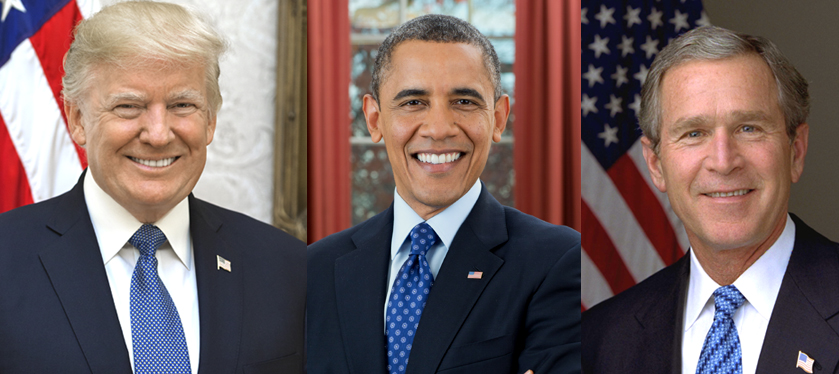
[1] The Bush Administration – Government Bails Out Big Institutions
The last recession was heavily related to easy credit in the housing industry. What helped the U.S. economy in recovery was that just after President-Elect Obama won the 2008 Election, the Bush Administration decided to guarantee some $7.75 Trillion dollars in assets. Keep in mind that the U.S. government did not have this money; nor could it realistically borrow this money. The idea was that the government would effectively put a floor on assets and with such guarantees of no losses, businesses got back into business again.
The government also decided after a series of bank and insurance failures, that major financial institutions could no longer fail. In order to try and fool the financial markets from shorting the stock of weak financial institutions, the U.S. Government forced major banks to take bailout money whether they needed it or not.
In the End, the Bush Administration racked up $4.9 Trillion over eight years as POTUS. About $2 Trillion of that was due to a combination of the 9/11 Terror Attacks (some $150+ Billion in gov and non-gov costs), Hurricane Katrina ($100 Billion), Iraq War ($709 Billion), War in Afghanistan ($171.7 Billion), and the $700 Billion TARP (bank-insurance bailout program).
[2] Obama & Dems Take Over Gov. —- And Industry
In 2009, then President Obama was correct to say that the economy would probably get worse before it gets better. From 2009-2011, President Obama along with the House and Senate were under total control of the Democrat Party.
With Democrats in control of government, they thought the best way for further economic recovery, was to first seize major industries.
Obama’s then Chief of Staff, Rahm Emanuel, said ‘you never let a crisis go to waste…where one could do things that they could not do before.’
Video: Original Link
This raises the question of what kind of measures was Obama’s Chief of Staff thinking of? Would the American public not ordinarily agree with extreme actions by the U.S. Government? Or did Mr. Emanuel imply that under certain circumstances, one might get away with something that is questionably ethical or legal?
Mr. Emanuel was previously named to Freddie Mac‘s Board of Directors under president Bill Clinton. Emanuel was tied up in financial scandals including misleading Freddie Mac shareholders, and personally profiting from the sale of stock via insider trading. He later resigned. CNN omitted his financial scandal with the quasi government mortgage giant. In September 2008, the Bush Admin. took over both Freddie Mac and Fannie Mae, which became under the Obama Admin.’s control in January 2009.
The Obama Admin. then began taking advantage of the financial crisis by trying to control or seize industries by taking over GM, Chrysler, Sallie May, one-third of Citigroup, and really wanted to control all the big banks. The Obama gov guaranteed assets beyond the previous said $700 Billion Bush’s bailout programs. The Obama Admin. guaranteed a whopping $11 Trillion in bailout commitments, including the costs of Obama’s ‘economic stimulus’ programs. The actual potential bailout commitment risk the Obama gov took was over $24 Trillion.
Again, keep in mind that the government did not have this money, they could not even borrow it if they had to. If the government needed that kind of money, they would just had to print it (devaluation of the dollar), thus making the buying power of your dollar worth even less.
At this point, the U.S. gov (via an “economic crisis”), controlled two-thirds of U.S. auto industry, controlled U.S. auto financing giant, GMAC, controlled major insurance, controlled major housing lenders, controlled student loans, controlled parts of major banks, and was on its way to control healthcare.
The next step for economic stimulus was to have the government spend their way to prosperity.
[3] Spending the Way to Prosperity?
Economically speaking, spending the way to prosperity is a strategy that just doesn’t work. If not sure, try this:
Max out all our credit cards, borrow 100% from your home equity-line, and borrow more money than you could ever repay. Then spend that borrowed money. Now try and figure out how to pay all that borrowed money back. Doesn’t work right? What you have is a ton of debt, and no plan to get you out of debt. That is exactly what Obama and Dems did.
The Obama gov borrowed over $3 Trillion dollars in Obama’s first year as POTUS, and (in total) nearly $6 Trillion dollars of debt spending in Obama’s first four years.
The Democratic congress also changed the rules on how the TARP money was to be spent. This allowed Obama to spend an extra $350 Billion UNRELATED to bailout programs previously allocated under the Bush Administration.
Obama said he would create 3-4 million jobs including 500,000 in renewable fuel technology programs such as windmills. The money got spent; but the jobs and renewable energy programs fell short of expectation. Many of the green energy jobs went bankrupt or were in financial turmoil.
Then a new $700 Billion ‘Economic Stimulus Plan’ was supposed to create “shovel ready jobs.” Obama later admitted that ‘shovel ready’ was not as he expected (i.e. Government-backed jobs plan did not work).
[4] More Regulations Did Not Create Jobs
Then Senator Barack Obama acknowledged that the U.S. government for creating the housing-credit crisis.
“We cannot give a blank check to Washington with no oversight and accountability, when no oversight and accountability is what got us into this mess in the first place…”
(We must) “eliminate the waste and the fraud and abuse in our government.”
— Senator & 2008 Presidential Candidate, Barack Obama (Source: CNN, Sept. 22, 2008).
Putting accountability in government, reducing government fraud and waste sounded real good; but what happened after the election was a bit different.
Instead of streamlining and reforming government, Obama choose penalize businesses with new government regulations?
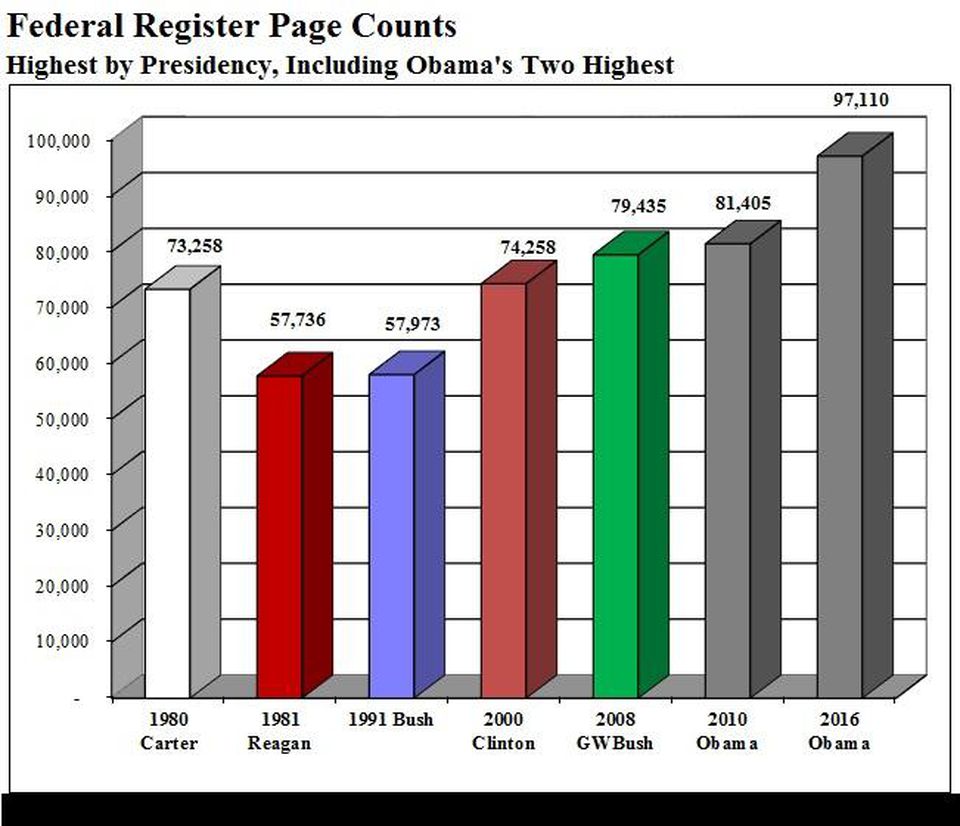
Massive new government regulations did not help boost the U.S. economy either. The EPA alone had over one million rules of government red tape. A 2017 report stated that the massive increase in government regulation cut $2 Trillion from U.S. economic growth.
Our 2016 report found that higher taxes, greater government control on business regulations with new built in taxes on healthcare, more gov spending, and increased regulation, put the U.S. economy and consumers in poor shape. As a result, American’s medium household income fell under Obama, and was higher under President Bush for about 6-7 years (chart below).
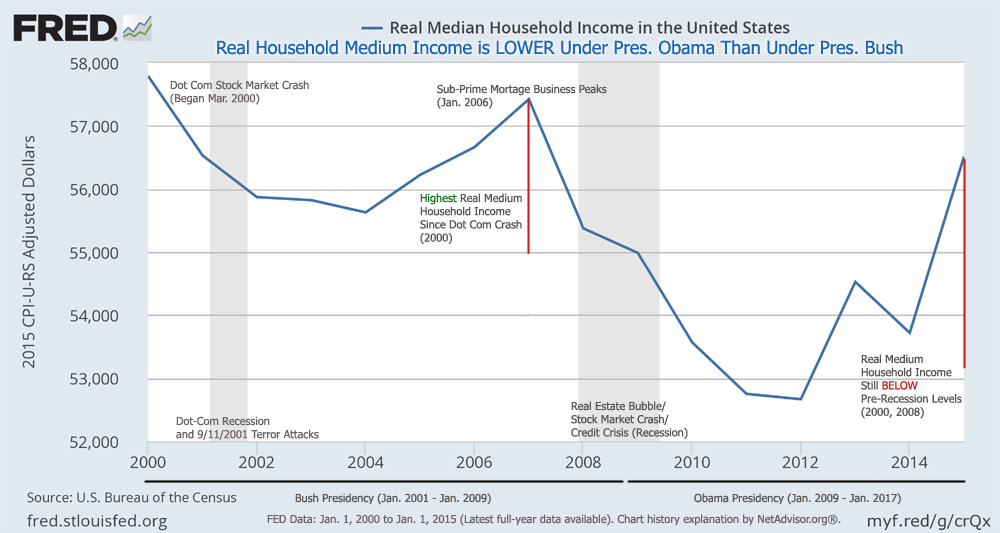
Unfortunately, this so-called government reform plan, didn’t reform government at all. Worse, these ‘reforms’ created a lackluster economy and impacting jobs.
The Obama Administration just came out and said some of America’s manufacturing jobs would not come back. Obama also said ‘we’ve seen more manufacturing jobs created at any time since 1990’s.’ The truth however is that under the Obama Admin., the U.S. did recover some lost manufacturing jobs that occurred during the recession, but we still had a net loss of 303,000 manufacturing jobs since 2009.
“White House Press Secretary Josh Earnest said that 805,000 manufacturing jobs have been created since President Barack Obama has been in office. In fact, there has been a net loss of 303,000 manufacturing jobs since January 2009.”
— Source: FactCheck.org, Dec. 1, 2016
Most people might consider building vehicles, making steel, and heavy equipment, etc., as manufacturing jobs. To help create the illusion of manufacturing jobs recovery, the Obama Admin. changed the definition of a manufacturing job. If you are a food-processor, such as Twinkies, you now have a “manufacturing job.”
[5] Gov Forcing Higher Wages on Private Business is Not ‘Stimulus’
The Obama Admin. also tried to force companies to pay higher wages as an ‘economic boost’ to the economy. We’ll, most everyone might like to have more pay, however if a company is forced to spend more money such as on managing government regulations and increased healthcare costs, and the economy is barely growing, how do you justify paying people more?
The business has to make money and sustain the business with an overall demand for its products and services before they can afford to bump wages higher. As the business comfortably grows and sees sustained earnings, they can raise wages. If the business does not see sustained growth, or if there are economic policy or costly regulation risks, the business is less likely to raise wages.
[6] Consumers Pay More On Wage Increases
When companies increase wages, they almost never just absorb the costs which decreases their profits; they raise prices which impact consumers. So in reality, consumers are paying for the wage hikes, not the businesses. As the cost for products and services increase, so does inflation. That inflation can wipe out the wage increase as consumer have to pay more for the same things they did before when they had lower wages.
[7] Gov Control & Debt Spending Did Not Create Utopia
With the government in control of healthcare, student loans, borrowed and spent $9.3 Trillion over eight years, did not create the economic prosperity Democrats had hoped for.
By 2016, Obama’s last year in office, more Americans were found to be in poverty since 1959, GPD growth was on the decline, we were losing jobs to foreign countries, and welfare was at record highs.
[8] It’s Magic?
Somehow, we are told to believe that with eight years of this negative economic picture, it magically turned around only after Obama left office, and Obama now deserves all the economic credit?
Some like to think that the current economy is really a ‘continuation’ of the Obama economy. We’ll the above data shows what eight years of the Obama economy was like; and a ‘continuation’ of that, is exactly what Americans did not want.
So what really made the U.S. economy boom again?
[9] Enter the Trump Administration
Whether one likes or dislikes the current or past President is irreverent here. Again, we are looking at the economic impact of policies of an Administration that can have a big influence on Americans.
The Trump Administration did not come out with the same economic policies that did not work in the past such as multi-trillion dollar government spending stimulus programs. Nor did the Trump Administration seek to increase regulations that have stifled the growth of businesses.
The first move of the Trump Administration was to try and take on the massive government takeover of healthcare.
[10] Healthcare
In 2017, the Trump Administration first tried to cut a leading costly government-ran program implemented in 2010: Obamacare.
Obamacare was barely passed by the Senate. It only got passed by using rare rules to ignore the entire U.S. House of Representatives; have the U.S. Senate just deem a bill as passed by the House, when in fact, it was never permitted to be voted on by the elected House members. This rule is very dangerous as it ignores the majority members of Congress (435) where they have no vote. the U.S. Senate has 100 members.
The Trump Admin. attempted to fully repeal ObamaCare with GOP House and Senate control. Republicans had a simple majority (51 votes) in the Senate, but to bypass a (D) challenge, they needed 60 Senate votes to get major legislation passed short of using the “Nuclear Option.” This effort fell short with one (R) holdout, the late Senator John McCain (R-AZ).
McCain and Trump had a long feud, and despite media perception today, McCain acted as the guy to ‘stick it’ back to Trump by voting against repeal.
Disagree? Let’s look at McCain’s recent views on Obamacare before Trump.
“The Arizona Republican (Sen. John McCain) has made his opposition to Obamacare — which dominated Senate races across the country six years ago…”
“Eight of the counties in my state will now only have one [health insurer]. They’re staring at 65 percent increases in their premiums. They’re very upset,” (McCain Said).
“Obamacare is failing Arizonans,” the narrator says in McCain’s first TV ad, which started airing last month. “First, a massive rate hike — more than twice the national average. Then America’s largest health insurer abandoned Arizona’s failing Obamacare exchange.”
— Source: Politico, 06-22-2016 (website)(PDF Archive)
So, McCain realized the high costs of Obamacare, the high costs of this government-ran healthcare program on the people in his own state. McCain then ran TV ads AGAINST Obamacare. So, when McCain had his chance to help a GOP-Senate to repeal Obamacare, McCain voted….no?
As expected, Trump was upset at McCain’s ‘no’ vote on repealing Obamacare, but said, his Administration has gutted Obamacare including eliminating the individual mandate and cutting regulations. The individual mandate made it a crime to if you did not pay money – [a special tax of $695 per uninsured adult ($347.50 per uninsured child), or 2.5 percent of your household income] to the government for the pleasure of not having healthcare insurance.
If one could not afford healthcare, there are state and federal programs that existed before Obamacare and currently. This federal penalty will be removed effective Jan 1, 2019.
Complete repeal of Obamacare is still on hold, but removal of the mandate forcing people to pay an extra tax (penalty), cutting other regulations, and giving more power back to the states (523 PPS Healthcare reform doc) are a few steps to reform.
In 2014, we published this report: 10 Things Congress Can Do to Reduce Health Care Costs Now.
Trump then moved to get Americans back to work.
[11] Wasting No Time, Trump Goes to Bat for America
Trump got Japan’s Softbank to commit investing $50 Billion in the USA, creating 50,000 USA jobs. Now, here’ the kicker. Trump got this commitment a month after the 2016 election, which was about a month before he was officially President.
Instead of having meetings about what new global regulations we need to fight “Climate Change” with European politicians, Trump met with top EU CEO’s about investing EU money in America. The CEO’s went one-by-one talking about new investment plans in the USA because of the…wait for it….
…new lower U.S. corporate tax rates.
“In a stunning moment, one by one, European titans of industry from companies like Adidas, Siemens and Bayer went around the table to thank Trump for the passage of tax cuts and the easing of corporate tax burdens. Almost every CEO had a new US-based investment or strategic business to announce.”
— Source: Daily Caller, Jan. 25, 2018 (Website/ Board Meeting Video)
As POTUS, Trump moved on his promise to cut taxes and bring jobs back to America.
[12] How Trump Helped Getting America Back to Work
Instead of the previous Administration raising nearly $2 Trillion in new taxes, increasing taxes on investing, taxing healthcare in multiple areas, increasing payroll taxes again in 2013 on 160 Million working Americans, the Trump Administration took a different route.
The Trump Administration realized that taxing people to death is not the path to prosperity.
U.S. Businesses had among the highest corporate taxes in the world now down from 35 percent to 21 percent.
The Trump Administration made the biggest tax cuts in over 30 years (since Reagan, 1986). Trump cut both federal and corporate income taxes. Cutting taxes for individuals and families is a good start. We like to see more of that, which could be in the future.
Instead of going on an overseas Apology Tour, professing beliefs of how bad America has been in the past; Trump called upon businesspersons and top CEO’s to the White House. The goal was getting America back to work.
Not all the CEO’s were Trump supporters, and a few refused to show up. But all CEO’s have one primary goal in common: Make money for the shareholders. With Trump’s showmanship, he spoke with CEO’s on Trump’s idea that America was the best place for business and how these companies could profit by this.
American business realized they were suddenly going to have a ton of cash from tax savings and began sharing more of that money with employees.
[13] Companies Dole Out Bonuses & Increase Wages After Tax Cuts
Companies are citing the Trump Tax Cuts as the reason for giving out bonuses and higher wages to employees.
None of these kind of mass worker bonuses, profit sharing or wage increases occurred under the Obama Administration because there were no incentives to do so. Left-leaning Tax Policy Center said that most Americans will see a tax cut this year and only a small percent will see a tax hike.
“In 2018, 80 percent of taxpayers would receive a tax cut from the included provisions–averaging about $2,100 — and about 5 percent would face an average tax increase of about $2,800.
In the middle income quintile, 91 percent would receive a tax cut and 7 percent would face a tax increase.
In the top 1 percent of the income distribution, 91 percent would receive a tax cut and 9 percent would face a tax increase.”
— Source: Tax Policy Center (PDF), 12-18-2017
By February 2018, some 400 corporations responded by giving out bonuses to workers. Walmart for example is giving out bonuses to workers, and increasing wages. Companies such as CVS, Target, Costco for example, are all increasing employee pay.
Wages are finally going up, not huge, but going up. In fact, wage increases are now at the highest rate in 18 years.
General Motors announced a profit-sharing program where nearly 50,000 union workers will receive about $12,000 extra. Fiat Chrysler came out with new U.S. manufacturing investment and worker bonus plan. The company also said it was distributing bonus checks to hourly union workers averaging $5,500 each. Ford said it has an existing bonus plan in place and in 2017 paid out $9,000 to employees.
House Minority Speaker, Nancy Pelosi (D-CA) called the Trump Tax Cut/ Bonuses “crumbs”…”so pathetic”…and…”insignificant.”
Pelosi has been in state or federal government for 37 years, and reportedly has a net-worth over $26 Million. Picking up an extra $1,000, $5,000 or more, and pay rise might be ‘crumbs’ to a mega-millionaire politician, but to most people, every extra bit of cash coming in helps.
[14] Cash Coming Back to America
The Trump corporate tax cuts had another effect.
In the first quarter 2018, and note – AFTER – the Trump Tax Reform Bill was signed, some $300 Billion of profits from U.S. companies made oversees came back to the U.S. This was the largest repatriated funds since at least early 2000’s.
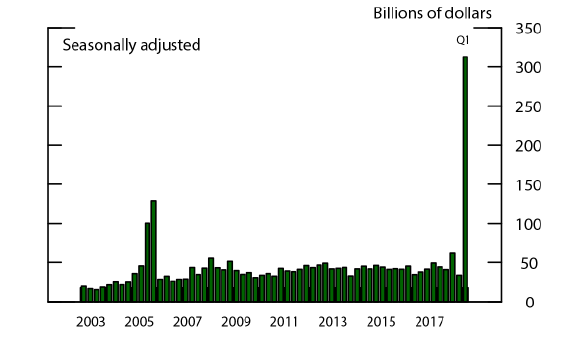
U.S. Companies who repatriate their cash profits held overseas back to the USA pay a one-time 15.5 percent tax instead of the 35 percent tax. Keep in mind those profits were already taxed in the foreign country in which they were earned. The top 16 U.S. companies reportedly are holding some $1 Trillion+ cash overseas. Bringing home this cash back to the USA gives companies opportunities to do something with it domestically.
The world’s largest company in terms of market capitalization, Apple, said they will invest $350 Billion in the USA (including with repatriated money), creating another 20,000 USA jobs over the next five years.
AT&T is investing $1 Billion in the USA and granting $200 Million in bonuses which works out to be $1,000 for 200,000 workers. AT&T said its investment and bonuses are related directly to Trump’s Tax Reform Act.
“Congress approved legislation representing the first comprehensive tax reform in a generation.
AT&T plans to invest an additional $1 billion in the United States in 2018 and pay a special $1,000 bonus to more than 200,000 AT&T U.S. employees — all union-represented, non-management and front-line managers.”
Many in the media have tried to spin the benefits of the tax cuts for companies and for individuals as more harmful than good.
[15] Fake News
Many in the supposedly independent media who politically disfavor the current Administration have written about what a disaster the tax cuts would be, how it would hurt workers and the economy. Yes folks, there are people so economically blind, and have the gull to argue that the more money you get to keep actually will hurt you?
We’ve heard some argue that lower taxes will decrease federal tax revenues. Really?
[16] LOWER Taxes Brings in More $$$ to U.S. Treasury
Many in the media won’t discuss how lowering taxes actually created more tax revenue for the U.S. Treasury. Since the Trump Tax Cuts, the U.S. Treasury saw a surplus in tax receipts of $214 Billion in April 2018. In the same period in 2017, the U.S. Treasury saw a tax surplus of $182 Billion.
“The U.S. government recorded a (record) $214 billion budget surplus in April as individual income tax receipts surged, the Treasury Department said on Thursday.
That compared to a budget surplus of $182 billion in the same month last year, according to the Treasury’s monthly budget statement.”
— Source: Reuters (website) (PDF Archive)
So, lower taxes brings in more tax revenue? Yes.
There is still more growing government debt, but at least not at the same spending rate as in 2009-2015, and the current Administration needs to get on this over the next year.
Congress has an addiction, and it’s called spending. If Trump can get Congress to cut not just deficit spending, but actually put the U.S. on a path by paying down the U.S. debt, it will be another huge accomplishment. We’re cautiously optimistic.
[17] Wage Growth
Despite the massive news of benefits to workers in terms of higher wages, and bonuses; some still try and argue that workers are not benefiting from tax cuts. However, wage growth has actually been INCREASING, after the tax cuts took effect this year.
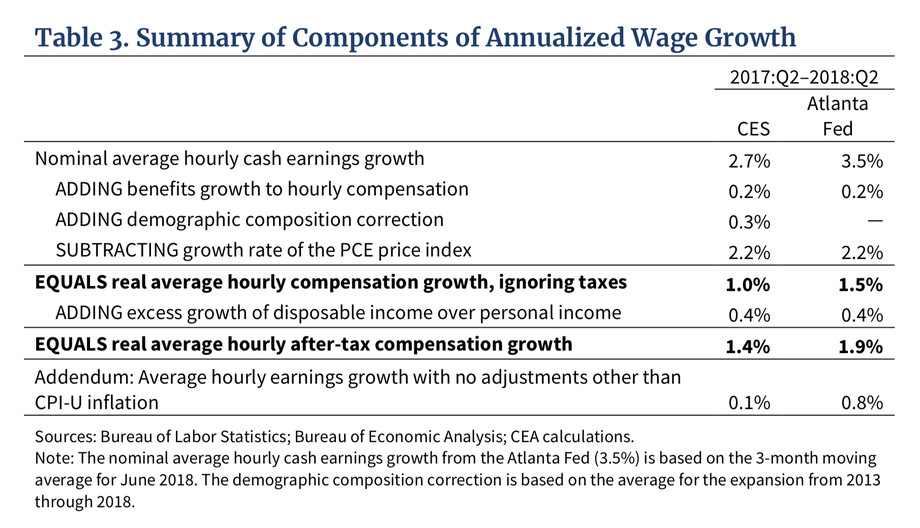
This wage growth did not benefit just the so called “rich” – it has helped a majority of Americans.
As for some who think the tax cuts are for the rich, guess again.
[18] Americans Have Money Again
A U.S. Dept. of Commerce report for the first quarter ending April 2018, shows that Americans have money again.
- “Current-dollar personal income increased $182.1 billion in the first quarter…
- Personal current taxes decreased $40.1 billion in the first quarter…
- Disposable personal income increased $222.1 billion, or 6.2 percent, in the first quarter…
- Personal saving was $462.1 billion in the first quarter…”
U.S. Consumers are spending money again. Consumers are shopping at the old brick-and-mortar stores again and the result:
“Walmart sales growth was the best in a decade” – CNN (Aug. 16, 2018)
“Target records best sales gain in more than a decade…” – Los Angeles Times (Aug. 22, 2018)
“August Sales Send Costco Stock to New Record” – Barron’s (Sept. 7, 2018)
Did we see any of these headlines in the last 10 years? No.
Again, policy making does play a big role on how bushiness operate and how or if consumers spend their money.
[19] Results
The results of our findings suggests the economic policies implemented by the Obama Administration did not result in booming economic growth. Raising taxes, adding new healthcare taxes on consumers, and increasing regulations did not grow the economy to any significant factor.
Even CNN had to admit that under the Obama Administration:
“Yes, this is the slowest U.S. recovery since WWII…
The U.S. economy has only grown 2% a year since it bottomed out in June 2009. That’s far below the typical growth in rosy times of over 4% a year that the U.S. has experienced since World War II. It’s even below the rather sluggish rebound during President George W. Bush’s tenure of 2.7%.
So it’s a fair statement.”
— Source: CNN, Oct. 5, 2016 (website)(PDF Archive)
The data also shows that there are specific (above said) economic policies implemented by the current (Trump) Administration that has thus far are showing to have a direct positive economic impact on the economy, and jobs.
Obama and Dems could have implemented these same policies in 2009-2010, etc., but Obama and his party’s ideology chooses not follow this kind of economy policy, and hence we had staggering growth.
Thus to argue that the current economic boom was started by the Obama Administration is thus unfounded. We welcome anyone who can point out specific tax or other economic policies that the Obama Administration actually did that can be directly tied to justify such claim.
[20] Dems Vow to Raise Taxes, if They Win This November
All of this economic work by the current Administration was designed to boost the economy, and has. Democrats in the U.S. House and Senate *ALL* voted AGAINST the tax cuts. Democrats now vow to kill the tax cuts and RAISE taxes just like they did under Obama if they control the House and Senate this fall in the Mid-term Elections.
This move my Dems could and likely have a huge negative impact on financial markets, business development, personal and wage incomes, and job growth if the current economic trend is broken.
Dems have also promised to try and Impeach Trump if they regain the House and Senate merely because they don’t like him. Dems also promised to abolish ICE police, end border security, and probably go back to appeasing our enemies. So if one is looking for massive chaos in the future, there it is.
Our research views are independent from the two major political parties. We look at intended and actual implemented government policies of the major parties, and post analysis and results thereof.
Did the U.S. Economy Avoid a Double-Dip Recession?
Will be discussing all this in our next report. Hit subscribe (it’s free, we don’t exchange/ give/ rent/ sell etc., your info). Follow NetAdvisor on twitter for latest interim posts, fact checking, and clarity of news events.
Images may be copyright by their respective owner.
Original article content, Copyright © 2018 NetAdvisor.org® All Rights Reserved.
NetAdvisor.org® is a non-profit organization providing public education and analysis primarily on the U.S. financial markets, personal finance and analysis with a transparent look into U.S. public policy. We also perform and report on financial investigations to help protect the public interest. Read More.

